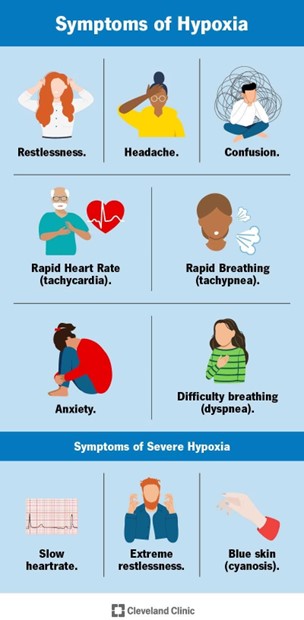The child is a 2-year-old who fell into a pool. He was retrieved from the pool by a family member but was not breathing. The family member started CPR, and the ambulance brought him to the hospital.
What factors are important in determining the level of hypoxemia that the child may have experienced during the submersion?
Select all that apply.
Temperature of water
The weight of the child
Oxygen concentration of the ambient air
Whether or not anyone witnessed the fall into the pool
The amount of time the child was submerged
Correct Answer : A,E
The level of hypoxemia that the child may have experienced during the submersion depends on several factors, but the most important ones are:
- The **temperature of water**: Cold water can induce a diving reflex, which lowers the heart rate and oxygen consumption, and may protect the brain from hypoxic injury¹². Cold water can also cause laryngospasm, which prevents water aspiration but also impairs gas exchange.
- The **amount of time the child was submerged**: The longer the submersion, the more severe the hypoxemia and the higher the risk of brain damage and death. The survival rate decreases significantly after 5 minutes of submersion³.
The other factors are less relevant or not directly related to the level of hypoxemia:
- The **weight of the child**: This may affect the buoyancy and the ability to float or swim, but not the oxygen consumption or gas exchange during submersion¹.
- The **oxygen concentration of the ambient air**: This may affect the pre-submersion oxygen saturation, but not the rate of oxygen depletion or gas exchange during submersion¹.
- The **witnessing of the fall into the pool**: This may affect the time to rescue and resuscitation, but not the level of hypoxemia during submersion.

Nursing Test Bank
Naxlex Comprehensive Predictor Exams
Related Questions
Correct Answer is A
Explanation
A) Correct- Electrolyte imbalances, particularly involving electrolytes like potassium, can lead to cardiac arrhythmias. Elevated blood pressure can strain the cardiovascular system, and mental status changes could indicate potential neurologic and cardiovascular involvement. Auscultating for an irregular heart rate helps identify any immediate cardiac issues that require intervention.
B) Incorrect- While monitoring sodium intake is important for clients with chronic kidney disease, it is not the most urgent action in this scenario. The presence of electrolyte imbalance, elevated blood pressure, and changes in mental status indicate a more acute concern that requires immediate assessment.
C) Incorrect- Documenting abdominal girth is relevant for assessing fluid status, but in this situation, the presence of electrolyte imbalance, elevated blood pressure, and mental status changes indicates a more critical issue that requires prompt intervention.
Correct Answer is B
Explanation
- A bowel pattern is the frequency, consistency, and appearance of a person's bowel movements. A normal bowel pattern is what's normal for each person, and it can vary depending on factors such as diet, age, physical activity, and health conditions.
- A focused gastrointestinal system assessment includes collecting subjective data about the patient's history of gastrointestinal disease, signs and symptoms of gastrointestinal problems, diet and nutrition, and bowel patterns. It also includes inspecting and auscultating the abdomen for any abnormalities.
- When a client reports having a bowel movement three days ago, the first action that the practical nurse should implement is to determine the client's usual bowel pattern. This will help to evaluate if the client is experiencing constipation or if this is their normal frequency. It will also help to identify any changes or risk factors that may affect the client's bowel function.
Therefore, option B is the correct answer, while options A, C, and D are incorrect.
Option A is incorrect because administering a stool softener without assessing the client's bowel pattern may not be appropriate or effective.
Option C is incorrect because encouraging ambulation may help to stimulate bowel activity, but it is not the first action to take.
Option D is incorrect because recommending dietary changes may be helpful for preventing or treating constipation, but it is not the first action to take.
Whether you are a student looking to ace your exams or a practicing nurse seeking to enhance your expertise , our nursing education contents will empower you with the confidence and competence to make a difference in the lives of patients and become a respected leader in the healthcare field.
Visit Naxlex, invest in your future and unlock endless possibilities with our unparalleled nursing education contents today
Report Wrong Answer on the Current Question
Do you disagree with the answer? If yes, what is your expected answer? Explain.
Kindly be descriptive with the issue you are facing.
